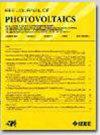新型微型热电联产模块的额定功率和运行影响因素
IF 2.6
3区 工程技术
Q3 ENERGY & FUELS
引用次数: 0
摘要
微聚光光伏(micro-CPV)技术具有促进能源转型的潜力,通过将最小的碳足迹和能源需求与低水平电力成本相结合,促进向更可持续和可再生能源的转变。微型cpv模块利用直接的正常辐照度将太阳光转化为电能,需要精确的太阳跟踪。在室外运行时,这些模块的性能受其朝向太阳和普遍室外条件的影响。光谱条件与环境温度、辐照度和风速一起影响多结太阳能电池的电流-电压特性和透镜的光学性能。我们开发了一种基于低成本和高通量制造工艺的新型微cpv模块概念。在这项工作中,我们提出了一个10 × 6阵列配置的原型模块(205-cm2孔径面积,子模块类)。我们讨论了一年多的室外测量记录和各种室外条件的影响。在IEC62670-3额定功率中,在浓缩器标准测试条件和浓缩器标准操作条件下,效率分别为36.0±0.4%和33.0±0.4%。当光谱匹配比SMR12为0.94±0.03时,效率最高,比标准条件下高0.4%左右。使用测量在不同的温度,我们表明,平凸硅-玻璃一次透镜有一个可以忽略不计的温度依赖性。在一年的过程中,模块性能的变化进行了讨论。尽管采用了市售的低成本组件和高通量工艺,但在第一年的运行中没有观察到明显的退化。本文章由计算机程序翻译,如有差异,请以英文原文为准。
Power Rating of a Novel Micro-CPV Module Concept and Operational Influences
Micro-concentrating photovoltaic (micro-CPV) technology has the potential to contribute to the energy transition, facilitating the shift toward more sustainable and renewable energy sources by combining minimal carbon footprint and energy demand with low levelized cost of electricity. Micro-CPV modules utilize direct normal irradiance to convert sunlight into electrical power, necessitating precise solar tracking. The performance of these modules is influenced by their alignment toward the sun and prevailing outdoor conditions during outdoor operation. The spectral conditions, along with the ambient temperature, irradiance, and wind speed, influence the current–voltage characteristics of multijunction solar cells and the optical behavior of the lens. We have developed a novel micro-CPV module concept, which is based on low-cost and high-throughput manufacturing processes. In this work, we present a prototype module in a 10 × 6 array configuration (205-cm2 aperture area, submodule class). We discuss outdoor measurements recorded over one year and the influences of various outdoor conditions. In an IEC62670-3 power rating, efficiencies of 36.0 ± 0.4% and 33.0 ± 0.4% at concentrator standard test conditions and concentrator standard operating conditions, respectively, are determined. Highest efficiencies, about 0.4% higher than at standard conditions, were attained at a more red-rich spectrum, namely at a spectral matching ratio SMR12 of 0.94 ± 0.03. Using measurements at different temperatures, we show that the planoconvex silicone-on-glass primary lens has a negligible temperature dependence. Changes in the module performance over the course of one year are discussed. Despite employing commercially available low-cost components and high-throughput processes, no significant degradation was observed during the first year of operation.
求助全文
通过发布文献求助,成功后即可免费获取论文全文。
去求助
来源期刊

IEEE Journal of Photovoltaics
ENERGY & FUELS-MATERIALS SCIENCE, MULTIDISCIPLINARY
CiteScore
7.00
自引率
10.00%
发文量
206
期刊介绍:
The IEEE Journal of Photovoltaics is a peer-reviewed, archival publication reporting original and significant research results that advance the field of photovoltaics (PV). The PV field is diverse in its science base ranging from semiconductor and PV device physics to optics and the materials sciences. The journal publishes articles that connect this science base to PV science and technology. The intent is to publish original research results that are of primary interest to the photovoltaic specialist. The scope of the IEEE J. Photovoltaics incorporates: fundamentals and new concepts of PV conversion, including those based on nanostructured materials, low-dimensional physics, multiple charge generation, up/down converters, thermophotovoltaics, hot-carrier effects, plasmonics, metamorphic materials, luminescent concentrators, and rectennas; Si-based PV, including new cell designs, crystalline and non-crystalline Si, passivation, characterization and Si crystal growth; polycrystalline, amorphous and crystalline thin-film solar cell materials, including PV structures and solar cells based on II-VI, chalcopyrite, Si and other thin film absorbers; III-V PV materials, heterostructures, multijunction devices and concentrator PV; optics for light trapping, reflection control and concentration; organic PV including polymer, hybrid and dye sensitized solar cells; space PV including cell materials and PV devices, defects and reliability, environmental effects and protective materials; PV modeling and characterization methods; and other aspects of PV, including modules, power conditioning, inverters, balance-of-systems components, monitoring, analyses and simulations, and supporting PV module standards and measurements. Tutorial and review papers on these subjects are also published and occasionally special issues are published to treat particular areas in more depth and breadth.
 求助内容:
求助内容: 应助结果提醒方式:
应助结果提醒方式:


